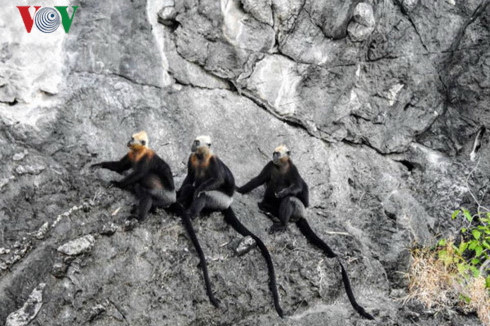
Cat Ba langur is the rarest primate in Asia, known to live only on Cat Ba Island, Hai Phong
The Cat Ba Langur Conservation Project is carried out on Cat Ba Island, a relatively primitive island district of Hai Phong City.Nguyen Huy Cam, deputy head of the Cat Dua rangers of Cat Ba National Park, said the Cat Ba langur is the rarest primate in Asia, known to live only on Cat Ba Island. There are only about 60 Cat Ba langurs scattered in the limestone mountains that run along the coast in Cat Ba National Park.
Mr Cam said “Cat Ba langurs live in the limestone mountains and eat various plants that grow on the cliffs. They usually sleep at night on the cliffs in caves, in the daytime eating and hanging out in the valley.”
To protect the species, the Cat Ba rangers have teamed up with local people who live in the buffer zone of the park to conduct regular patrols, destroy poachers’ traps, and keep a close protective watch on each langur.
“Langurs reproduce all year round but deliver only one offspring at a time. Langurs can sit quietly and not move for hours, so we have to be patient enough to wait for them to return to their sleeping caves so we can count them,” Cam explained.
Neahga Leonarg, Director of the Cat Ba Langur Conservation Project, said that the Cat Ba langur has genetic characteristics similar to the white-headed langur of Southern China, from which it split off millions of years ago, evolving to adapt to living in rugged limestone mountains. Cat Ba langurs are shy of humans, and might move from their cave to another place if they hear a strange sound miles away. The project must contend with many difficulties: the rugged terrain, poor public awareness, and economic and tourism activities which adversely affect the environment.
Cat Ba National Park is working with a number of foreign organizations to stabilize the langur population through increased communication to prevent poaching, set up a protected zone to ensure an appropriate habitat for the species, and increase the langur’s rate of reproduction.
Hoang Van Thap, the Director of Cat Ba National Park, said “Since Hai Phong City completed a detailed plan for a langur protection zone, our protection has been much more effective. Activities of locals have been restricted. Cat Ba Archipelago is rich in biodiversity. We should do all we can to preserve our natural heritage, minimize the impact of tourism and other activities, and see that socio-economic development respects and conserves nature.”
The Cat Ba Langur Conservation Project began in late 2000, sponsored by the Zoological Society for the Conservation of Species and Populations (ZGAP) and Germany’s Münster Zoo. Two models, called “Langur safeguards” and “the Forest Protection Club” have been successfully implemented in the communes of Cat Ba Island.

Leave your comment on this story